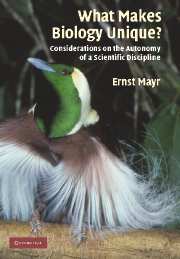Book contents
- Frontmatter
- Contents
- Preface
- Acknowledgments
- Introduction
- 1 Science and sciences
- 2 The autonomy of biology
- 3 Teleology
- 4 Analysis or reductionism?
- 5 Darwin's influence on modern thought
- 6 Darwin's five theories of evolution
- 7 Maturation of Darwinism
- 8 Selection
- 9 Do Thomas Kuhn's scientific revolutions take place?
- 10 Another look at the species problem
- 11 The origin of humans
- 12 Are we alone in this vast universe?
- Glossary
- Index
- References
8 - Selection
Published online by Cambridge University Press: 10 December 2009
- Frontmatter
- Contents
- Preface
- Acknowledgments
- Introduction
- 1 Science and sciences
- 2 The autonomy of biology
- 3 Teleology
- 4 Analysis or reductionism?
- 5 Darwin's influence on modern thought
- 6 Darwin's five theories of evolution
- 7 Maturation of Darwinism
- 8 Selection
- 9 Do Thomas Kuhn's scientific revolutions take place?
- 10 Another look at the species problem
- 11 The origin of humans
- 12 Are we alone in this vast universe?
- Glossary
- Index
- References
Summary
The cornerstone of darwin's paradigm of evolution was the theory of natural selection. Yet, of all his theories this was the last one to be adopted by his followers. It took some eighty years before it was fully accepted by biologists and, of course, even today it still encounters a good deal of resistance among laypersons, particularly those with religious commitments. Actually at the beginning there were good reasons for resistance. Most importantly, for a long time there was little convincing evidence for the occurrence of selection in nature. Such evidence has now been provided abundantly, both in the field and in the laboratory (Endler 1986, Futuyma 1999). But there was also considerable uncertainty about various specific aspects of the selection process.
I will not present a full treatment of the subject natural selection in this chapter for I have done so quite recently in What Evolution Is (2001: chapter 6, pp. 115–146). Instead I will single out for special treatment various aspects of selection about which there are still uncertainties.
What is selection?
In view of the persistent controversies, from 1859 on, concerning the nature of selection, it would seem most helpful to begin with a concise definition of selection, but this cannot be done owing to the arguments on the nature of this process. In 1963 I defined natural selection as nonrandom “differential reproductive success.” And this is even today a valid formulation, but it stresses the outcome of this process rather than its mechanism.
- Type
- Chapter
- Information
- What Makes Biology Unique?Considerations on the Autonomy of a Scientific Discipline, pp. 133 - 158Publisher: Cambridge University PressPrint publication year: 2004



